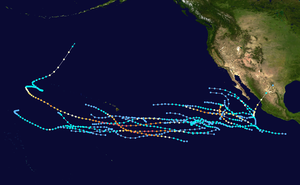
Back Pazifische Hurrikansaison 1994 German Temporada de huracanes en el Pacífico de 1994 Spanish Temporada de furacões no Pacífico de 1994 Portuguese 1994 Pacific hurricane season SIMPLE 1994年太平洋颶風季 Chinese
| 1994 Pacific hurricane season | |
|---|---|
 Season summary map | |
| Seasonal boundaries | |
| First system formed | June 18, 1994 |
| Last system dissipated | October 26, 1994 |
| Strongest storm | |
| By maximum sustained winds | John |
| • Maximum winds | 175 mph (280 km/h) (1-minute sustained) |
| • Lowest pressure | 929 mbar (hPa; 27.43 inHg) |
| By central pressure | Gilma |
| • Maximum winds | 160 mph (260 km/h) (1-minute sustained) |
| • Lowest pressure | 920 mbar (hPa; 27.17 inHg) |
| Seasonal statistics | |
| Total depressions | 22 official, 2 unofficial |
| Total storms | 20 |
| Hurricanes | 10 |
| Major hurricanes (Cat. 3+) | 5 |
| Total fatalities | 4 total |
| Total damage | $720 million (1994 USD) |
| Related articles | |
The 1994 Pacific hurricane season was the final season of the eastern north Pacific's consecutive active hurricane seasons that started in 1982. The season officially started on May 15, 1994, in the eastern Pacific, and on June 1, 1994, in the central Pacific, and lasted until November 30, 1994. These dates conventionally delimit the period of each year when most tropical cyclones form in the northeastern Pacific Ocean. The first tropical cyclone formed on June 18, while the last system dissipated on October 26.[1] This season, twenty-two tropical cyclones formed in the north Pacific Ocean east of the dateline, with all but two becoming tropical storms or hurricanes. A total of 10 hurricanes occurred, including five major hurricanes. The above average activity in 1994 was attributed to the formation of the 1994–95 El Niño.
Of note in this season is an unusual spree of very intense storms; the season was the first on record to see three Category 5 hurricanes, later tied in 2002 and 2018. Hurricanes Emilia, Gilma, John, and Olivia all reached a pressure below 930 millibars. Hurricane John was the farthest-traveling tropical cyclone on record at 13,180 km (8,190 mi). Elsewhere, Hurricane Rosa caused four casualties in Mexico as the basin's only landfalling tropical storm or hurricane, and later was responsible for flooding in Texas.
- ^ "Eastern North Pacific Tracks File 1949–2007". National Hurricane Center. March 21, 2008. Archived from the original (Plaintext) on August 22, 2008. Retrieved September 23, 2008.